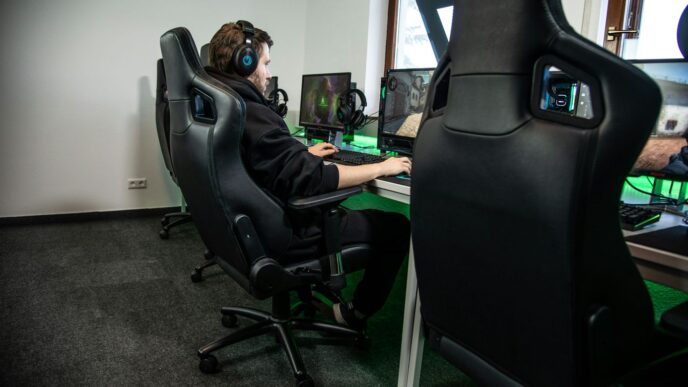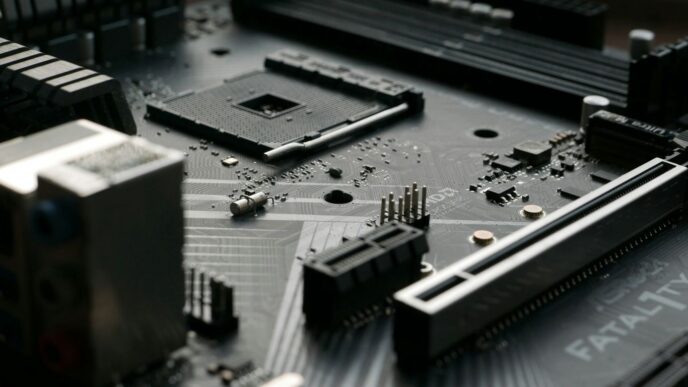Thinking about getting a new handheld gaming device in 2025? It’s a great time to be looking, with so many cool options out there now. Whether you’re a fan of Nintendo’s classics, want to take your PC games on the go, or just need something for quick gaming sessions, there’s a best gaming console portable for you. This guide will help you figure out what to look for and which ones are really worth your money. Let’s find your perfect gaming buddy.
Key Takeaways
- When picking the best gaming console portable, think about what games you play most. This helps narrow down your choices between Nintendo exclusives, PC titles, or something else.
- Look at the screen quality (OLED is usually better), how powerful the device is, and how long the battery lasts. These things really change how you play.
- The Nintendo Switch family offers great versatility and exclusive games, making it a strong all-around choice. The Lite is good for budget buyers, while the OLED model has a nicer screen.
- For PC gamers, the Steam Deck is a top pick, letting you play a huge chunk of your Steam library anywhere. It’s powerful and versatile.
- If you’re a PlayStation owner, the PlayStation Portal is fantastic for playing your PS5 games remotely, offering a comfortable and familiar controller experience.
Choosing Your Ultimate Portable Gaming Companion

So, you’re looking to grab a portable gaming console, huh? That’s awesome. The world of handheld gaming has really exploded lately, and it can be a bit overwhelming trying to figure out which one is actually right for you. It’s not just about picking the flashiest one; it’s about finding a device that fits how you play. Think about what kind of games you love and where you’ll be playing them most.
Understanding Your Gaming Needs
Before you even start looking at specs, let’s get real about your gaming habits. Are you someone who loves sinking hours into massive open-world RPGs, or are you more of a quick-session puzzle game player? Maybe you’re all about competitive online multiplayer, or perhaps you just want to revisit some old favorites from your childhood.
- Genre Preferences: Do you lean towards action, strategy, simulation, or something else entirely? Some handhelds are better suited for certain types of games.
- Play Style: Are you a couch gamer, a commuter, or do you play in short bursts throughout the day?
- Game Library: Do you have a specific collection of games you want to play, or are you looking for access to a vast new library?
Key Features to Consider
Once you’ve got a handle on your needs, you can start looking at what makes these devices tick. There are a few things that really stand out when comparing different handhelds:
- Screen Quality: Resolution, refresh rate, and whether it’s an OLED or LCD panel can make a big difference in how games look and feel.
- Performance: This relates to the processor and graphics chip. More power means you can play more demanding games smoothly.
- Battery Life: How long can you actually play before needing to find an outlet? This is a big one for portability.
- Storage: How many games can you install? Some devices have limited internal storage, while others support expandable options.
- Controls: Are they comfortable for long play sessions? Do they feel responsive?
Budget vs. Premium Options
Let’s be honest, price is always a factor. You’ve got everything from super affordable options that are great for casual gaming to high-end machines that will set you back a pretty penny. It’s a balancing act between what you can afford and what you’re getting for your money. Sometimes, spending a bit more upfront can get you a device that lasts longer and performs better. For instance, while the Lenovo Legion Go S SteamOS is a top-tier choice, there are also more budget-friendly devices that still offer a solid gaming experience. You don’t always need the most expensive gadget to have a good time.
The Top Contenders for Best Gaming Console Portable
Alright, let’s talk about the big players in the portable gaming world for 2025. It feels like just yesterday we were all glued to our TV screens, but now, the best gaming experiences can fit right into your backpack. It’s pretty wild how far these things have come, right? We’ve got a few devices that are really standing out, each with its own vibe and what it’s good at. If you’re trying to figure out which one is going to be your new best friend for gaming on the go, this is where we break it down.
Nintendo Switch Family: Versatility and Exclusives
Nintendo has always had a special place in gamers’ hearts, and the Switch family continues that tradition. The main draw here is the sheer flexibility. You can dock it to play on your TV, or just pick it up and go. It’s perfect for those who love Nintendo’s unique lineup of games – think Mario, Zelda, and all those other classics you can’t get anywhere else. The OLED model, in particular, has a gorgeous screen that really makes games pop, even if it’s not the newest kid on the block anymore. If you’re looking for a system that can do a bit of everything and has games you won’t find on other platforms, the Switch is a solid choice. It’s great for families, solo players, and pretty much anyone who enjoys Nintendo’s brand of fun.
Steam Deck: The PC Gamer’s Dream
For those of us who live and breathe PC gaming, the Steam Deck is a game-changer. This device lets you take your Steam library with you, wherever you roam. Seriously, a huge chunk of your PC games can run on this thing. The newer OLED version is even better, with a stunning display and improved battery life, meaning you can game for longer without hunting for an outlet. It’s not just about playing games, though; it’s about playing your games, the ones you’ve spent hours building up on your PC. It’s a bit more of a commitment, and maybe not as straightforward as a console for some, but the freedom it offers PC gamers is pretty incredible.
PlayStation Portal: Seamless Remote Play
Now, this one is a bit different. The PlayStation Portal isn’t a standalone console; it’s all about streaming your PlayStation 5 games. If you’ve got a PS5 and you often find yourself hogging the main TV, or you just want to play in another room, this is your ticket. It uses your Wi-Fi to stream games directly from your PS5. The design is really comfortable, borrowing heavily from the DualSense controller, which makes long gaming sessions a breeze. It’s not for everyone, especially if you don’t have a PS5, but for what it does – providing a dedicated, high-quality remote play experience – it’s pretty much unmatched.
Exploring Specialized Handheld Experiences
Sometimes, you don’t need a do-it-all device. Maybe you’re really into those old-school games, or perhaps you just want something that plays PC titles without a fuss. This section looks at handhelds that really nail a specific niche.
Best for Retro Gaming Enthusiasts
If your heart beats for the 8-bit and 16-bit eras, a dedicated retro handheld is the way to go. These devices are built from the ground up to play classic games, often with built-in libraries and support for cartridges from other systems. They usually have a simpler interface and are designed for comfort during long sessions of pixelated perfection.
- Super Pocket: This little guy is a fantastic option for retro fans. It comes with a solid collection of games pre-loaded and can also use Evercade cartridges, giving you access to a huge library of classics like Burger Time and Sly Spy. It’s super portable and easy to use.
- Evercade EXP: Another strong contender, the Evercade EXP focuses on physical cartridges, offering a curated selection of retro titles. It’s got a nice screen and feels good in the hand.
Windows Handhelds: Maximum Compatibility
For those who want to play their PC games on the go, Windows handhelds are the answer. These are essentially small Windows computers designed for gaming. This means you can install almost any PC game, from the latest AAA titles to your favorite indie gems, as long as your hardware can handle it. However, they can be a bit more complex to manage than dedicated consoles.
- MSI Claw 8 AI+: This one packs some serious power with its Intel Lunar Lake chip, making it great for running demanding games. The 8-inch screen is also a real treat.
- Lenovo Legion Go: If you like a bigger screen, the Legion Go boasts a massive 8.8-inch display. It also has detachable controllers, which is a pretty neat trick.
- Ayaneo Flip DS: This handheld is compact and surprisingly versatile. Its dual-screen setup is unique and makes navigating the Windows desktop much easier than you might expect.
Budget-Friendly Handhelds for Everyone
Not everyone wants to spend a fortune on a portable gaming device. Luckily, there are some great options that won’t break the bank. These devices might not have the absolute top-tier specs, but they still offer a fun gaming experience, especially for less demanding titles or older games.
- Nintendo Switch Lite: While not the cheapest, the Switch Lite is a fantastic budget option if you’re primarily interested in Nintendo’s exclusive games. It’s a dedicated handheld, meaning no docking to a TV, which keeps the cost down.
- Used or Older Models: Don’t forget to check out the used market! You can often find great deals on slightly older handhelds that still offer plenty of gaming fun.
- Lower-Spec Windows Handhelds: Some of the less powerful Windows handhelds can be found at more affordable prices, especially if you catch them on sale. They might struggle with the newest games, but they’re great for indie titles and older PC games.
Performance and Display: What Matters Most
When you’re looking at portable gaming consoles, the screen and how well it runs games are super important. It’s not just about how many fancy graphics a game has, but how smooth it feels to play and how nice it looks on the go.
OLED vs. LCD Displays
This is a big one. You’ll see two main types of screens: LCD and OLED. LCD screens are pretty standard and have been around forever. They’re usually fine, but sometimes colors can look a bit washed out, especially in darker games. OLED screens, on the other hand, are a game-changer for visuals. They have perfect blacks because each pixel lights up on its own. This means colors pop way more, and games with dark scenes, like spooky horror titles or space adventures, look absolutely stunning. The difference is really noticeable, making games feel more alive.
Processing Power and Game Libraries
How a console handles games depends a lot on its internal guts – the processor and graphics chip. More power means you can play newer, more demanding games. But it’s not just about raw power. Think about the games you actually want to play. Some handhelds are built for PC games, meaning they can run a huge library of titles, but might need some tweaking to run well. Others are more focused on specific game stores, like Nintendo’s eShop or Steam. You’ll want to match the console’s power to the types of games you enjoy. For example, if you’re into the latest AAA PC titles, you’ll need something with more horsepower than if you’re mostly playing indie games or older classics.
Battery Life and Ergonomics
Nobody wants their gaming session cut short because the battery died. Battery life is a huge factor for any portable device. Some handhelds can last for hours, letting you play through long flights or car rides, while others might only give you a couple of hours before needing a charge. It’s worth checking reviews to see real-world battery performance. Also, think about how the device feels in your hands. If you’re going to be playing for extended periods, a comfortable grip and well-placed buttons are super important. A device that feels awkward or causes hand cramps after an hour isn’t going to be much fun, no matter how good it looks or how powerful it is.
Making the Final Decision: Your Best Gaming Console Portable
So, you’ve looked at all the cool gadgets, read up on the specs, and maybe even watched a few unboxing videos. Now comes the part where you actually pick one. It sounds simple, but honestly, it can feel like a big decision. After all, this is your portable gaming buddy for who knows how long. Let’s break down how to make sure you’re not just buying a handheld, but your handheld.
Matching Handhelds to Your Lifestyle
Think about where and how you actually play games. Are you mostly commuting on a train, or do you mostly game from your couch while someone else hogs the TV? This stuff really matters.
- The Commuter: If you’re always on the go, battery life and how comfortable it feels in your hands for long stretches are super important. Something smaller and lighter might be better, even if it means sacrificing a bit of screen size or power. The Nintendo Switch Lite is a solid pick here, or maybe a more compact Windows handheld if you need PC games.
- The Homebody Gamer: If you’re playing mostly at home, maybe you want something that can connect to your TV sometimes, or something that can stream games from your main console. The PlayStation Portal is built for this if you’re a PS5 owner, and the standard Nintendo Switch models let you dock to a TV.
- The PC Enthusiast: If your heart belongs to PC gaming, then a device like the Steam Deck or a powerful Windows handheld is probably your only real choice. You want to play your existing PC library, and these are the machines that let you do that.
Considering Future-Proofing
Nobody wants to buy a new gadget only to have it feel outdated in a year. When you’re looking at these handhelds, think about what’s coming next.
- Software Support: How long is the manufacturer likely to support the device with updates and new games? Nintendo is usually good for a long time with its consoles. PC handhelds rely on the PC ecosystem, which is always moving forward.
- Hardware Specs: While you can’t always predict the future, devices with more powerful processors and better screens will generally hold up longer. The Steam Deck OLED, for example, has a great screen and decent power that should keep it relevant for a while.
- Upgradeability: Can you swap out the storage? Some devices let you add bigger SD cards, which is a nice way to keep more games on hand without buying a whole new unit.
Where to Find the Best Deals
Okay, so you’ve got an idea of what you want. Now, where do you actually get it without spending your entire savings?
- Official Retailers: Always check the main places like Nintendo’s store, Steam, or PlayStation’s direct site. They sometimes have bundles or special editions.
- Major Electronics Stores: Places like Best Buy, Amazon, or GameStop often have sales, especially around holidays. Keep an eye on their weekly ads.
- Refurbished Options: Don’t shy away from refurbished units. Many companies offer certified refurbished devices that come with a warranty and are significantly cheaper. It’s a great way to get a premium device for less.
- Used Market: If you’re really on a tight budget, sites like eBay or local marketplaces can be good, but be careful. Always check seller reviews and ask for details about the condition before buying.
So, What’s Your Next Gaming Companion?
Alright, we’ve looked at a bunch of these handheld gaming gadgets, and honestly, there’s something out there for pretty much everyone. Whether you’re all about Nintendo’s classics, want to take your whole PC library on the road, or just need something cheap and cheerful for some retro fun, the choices are pretty solid this year. Think about what games you play the most and where you’ll be playing them. That’s really the key to picking the right one. Don’t overthink it too much – the most important thing is to get something that lets you play the games you love, wherever you happen to be. Happy gaming!
Frequently Asked Questions
Which portable gaming system is best for me?
Think about the games you love to play! If you’re all about Nintendo games like Mario or Zelda, the Nintendo Switch is your go-to. For PC games on the move, the Steam Deck or other Windows handhelds are awesome. If you already have a PlayStation 5, the PlayStation Portal is perfect for playing those games anywhere.
What’s the difference between OLED and LCD screens on these devices?
OLED screens offer brighter colors and deeper blacks, making games look super vibrant and realistic. LCD screens are still good, but they might not pop as much. For the best visual experience, OLED is usually the top choice, but it can cost a bit more.
How important is battery life when picking a handheld?
Battery life is super important, especially if you plan to play away from a charger for a while. Some handhelds can last for many hours, while others might only give you a couple. Always check reviews to see how long the battery really lasts during gameplay.
Can I play older games on these new handhelds?
Yes, many handhelds are great for playing retro games! Some come with classic games built-in, while others can play special cartridges or even let you download old favorites. The Super Pocket is a popular choice specifically for retro gaming fans.
Are these portable gaming devices expensive?
Prices can vary a lot. You can find budget-friendly options like the Nintendo Switch Lite or the Super Pocket if you’re not looking to spend a lot. More powerful devices like the Steam Deck or premium Windows handhelds will cost more, but they offer a lot more gaming power.
What does ‘remote play’ mean for devices like the PlayStation Portal?
Remote play means you’re not playing the game directly on the device itself. Instead, the device connects to your main gaming console (like a PS5) over the internet and streams the game to its screen. It’s a great way to play your console games when the TV is being used by someone else.














